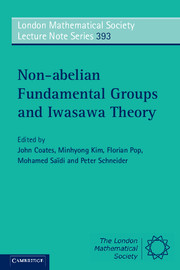Book contents
- Frontmatter
- Contents
- List of contributors
- Preface
- Lectures on anabelian phenomena in geometry and arithmetic
- On Galois rigidity of fundamental groups of algebraic curves
- Around the Grothendieck anabelian section conjecture
- From the classical to the noncommutative Iwasawa theory (for totally real number fields)
- On the MH(G)-conjecture
- Galois theory and Diophantine geometry
- Potential modularity – a survey
- Remarks on some locally ℚp-analytic representations of GL2(F) in the crystalline case
- Completed cohomology – a survey
- Tensor and homotopy criteria for functional equations of ℓ-adic and classical iterated integrals
Preface
Published online by Cambridge University Press: 05 January 2012
- Frontmatter
- Contents
- List of contributors
- Preface
- Lectures on anabelian phenomena in geometry and arithmetic
- On Galois rigidity of fundamental groups of algebraic curves
- Around the Grothendieck anabelian section conjecture
- From the classical to the noncommutative Iwasawa theory (for totally real number fields)
- On the MH(G)-conjecture
- Galois theory and Diophantine geometry
- Potential modularity – a survey
- Remarks on some locally ℚp-analytic representations of GL2(F) in the crystalline case
- Completed cohomology – a survey
- Tensor and homotopy criteria for functional equations of ℓ-adic and classical iterated integrals
Summary
In historical origins, serious topological input to arithmetic starts at the latest in the early years of the twentieth century with the foundations of class field theory by Takagi and Artin. Around the middle of the century, the rapid development of homological techniques in algebra led to an explosion of consequent activity in number theory and algebraic geometry, including the theory of coherent sheaves, the homological interpretation of Artin's reciprocity map, and Grothendieck's construction of arithmetic cohomology theories based upon the abstract notion of Grothendieck topologies. Then, in the 1980s, Grothendieck formulated his anabelian conjectures in the celebrated letter to Faltings, and brought to a hitherto-unexplored depth the interaction between topology and arithmetic. Therein came into focus the far-reaching vision that the perspective of non-abelian fundamental groups could lead to a fundamentally new understanding of deep arithmetic phenomena, including the arithmetic theory of moduli and Diophantine finiteness on hyperbolic curves. In the 1990s, profound (and perhaps unexpected) progress in Grothendieck's program was realized through the theorems of Nakamura, Tamagawa, Mochizuki. (See the contributions of Nakamura, Pop, and Saidi.)
Meanwhile, a certain amount of work in recent years linking fundamental groups to Diophantine geometry intimates deep and mysterious connections to the theory of motives and Iwasawa theory, notions usually associated to Diophantine problems involving exact formulae of which the most celebrated example is the conjecture of Birch and Swinnerton-Dyer (cf. Kim's article).
- Type
- Chapter
- Information
- Non-abelian Fundamental Groups and Iwasawa Theory , pp. vii - xPublisher: Cambridge University PressPrint publication year: 2011



